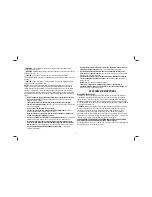
3
DCR017
FIG. 1
Extension Cords
CAUTION:
Use only extension cords that are approved by the country’s Electrical
Authority. Before using extension cords, inspect them for loose or exposed wires,
damaged insulation and defective fittings. Replace the cord if necessary.
WARNING:
We recommend the use of a residual current device with a residual
current rating of 30mA or less.
• The label on your appliance may include the following symbols. The symbols and
their definitions are as follows:
V ................. volts
A ...............amperes
Hz ............... hertz
W ..............watts
min ............. minutes
...........alternating current
........ direct current
...........alternating or direct current
.............. Class I Construction
.............earthing terminal
...................
...................
(grounded)
..............safety alert symbol
.............. Class II Construction
…/min .......per minute
...................
(double insulated)
SAVE ALL WARNINGS AND INSTRUCTIONS FOR
FUTURE REFERENCE
Important Safety Instructions for All Battery Packs
When ordering replacement battery packs, be sure to include the catalog number and
voltage. Consult the chart at the end of this manual for compatibility of chargers and
battery packs.
The battery pack is not fully charged out of the carton. Before using the battery pack
and charger, read the safety instructions below and then follow charging procedures
outlined.
READ ALL INSTRUCTIONS
•
Do not charge or use the battery pack in explosive atmospheres, such as in
the presence of flammable liquids, gases or dust.
Inserting or removing the
battery pack from the charger may ignite the dust or fumes.
• Never force the battery pack into the charger. Do not modify the battery pack
in any way to fit into a non-compatible charger as battery pack may rupture
causing serious personal injury.
Consult the chart at the end of this manual for
compatibility of batteries and chargers.
• Charge the battery packs only in designated D
E
WALT chargers.
•
DO NOT
splash or immerse in water or other liquids.
• Do not store or use the tool and battery pack in locations where the
temperature may reach or exceed 40 °C (105 °F) (such as outside sheds
or metal buildings in summer).
For best life store battery packs in a cool, dry
location.
•
Batteries shall not be exposed to excessive heat such as sunshine, fire or the like.
WARNING:
Fire hazard. Never attempt to open the battery pack for any reason. If
the battery pack case is cracked or damaged, do not insert into the charger. Do not
crush, drop or damage the battery pack. Do not use a battery pack or charger that
has received a sharp blow, been dropped, run over or damaged in any way (e.g.,
pierced with a nail, hit with a hammer, stepped on). Damaged battery packs should be
returned to the service center for recycling.
WARNING:
Fire hazard. Do not store or carry the battery pack so that metal objects
can contact exposed battery terminals. For example, do not place the battery pack
in aprons, pockets, tool boxes, product kit boxes, drawers, etc., with loose nails,
screws, keys, etc. Transporting batteries can possibly cause fires if the battery
terminals inadvertently come in contact with conductive materials such as keys,
coins, hand tools and the like. When transporting individual battery packs, make sure
that the battery terminals are protected and well insulated from materials that could
contact them and cause a short circuit.
SPECIFIC SAFETY INSTRUCTIONS FOR LITHIUM ION (Li-Ion)
•
Do not incinerate the battery pack even if it is severely damaged or is
completely worn out.
The battery pack can explode in a fire. Toxic fumes and
materials are created when lithium ion battery packs are burned.
Summary of Contents for DCR017-XE
Page 1: ...DCR017 XE CHARGER RADIO INSTRUCTION MANUAL ...
Page 2: ......






























